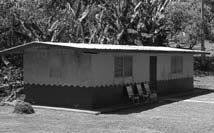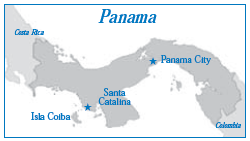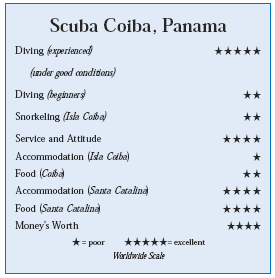Scuba Coiba, Panama, Pacific CoastContents of this Issue: Scuba Coiba, Panama, Pacific Coast DAN Debunks Antioxidants Before Diving Know Your Fish: Must-Read Books for Divers Get Published in the 2008 Chapbook! The Tactical Use of Dive Computers Sign Up for the "Best of the Web" Editorial Office: Ben Davison Publisher and Editor Undercurrent 3020 Bridgeway, Suite 102 Sausalito, CA 94965 from penal colony to protected marine site from the May, 2007 issue of Undercurrent
Dear Reader: Forty minutes into a dive on the Cholos sea mount, I peeked over a ledge to find an intense boil of whitetipped sharks. Several two-foot bluefin trevally jacks were in the action, along with scissortail chromis, Pacific creolefish and other small creatures at the edges of this mysterious fish blender. I, my two friends and our divemaster Glenn Messingham had front row seats at a display of pure energy, punctuated with strikes by one fish at another. It was but one of the dramatic scenes I saw underwater during my January stay at Isla Coiba, a 20-milelong island that lies 25 miles from the fishing town of Santa Catalina on Panama’s Pacific coast. The visibility and currents can be problematic, but the fish life is of Jurassic proportions. Glenn, who had promised me that he would find giant frogfish, made good on that same dive by finding three huge yellow ones. Cholos, like many dive sites around Isla Coiba, is like Cozumel, but with rocks. Huge pinnacles, cracks and ledges top out at 45 feet. The currents have mood swings, either coming from one direction or another or just lying still.
Undercurrent wrote about Scuba Coiba last year and
its mainland dives
near Santa Catalina,
but the prime diving
is found on its
three-day trips to
Isla Coiba. Until
recently, Isla Coiba
was a penal colony,
but thankfully it is
now part of Coiba
National Park and
UNESCO World Heritage
Site, about 1,000
square miles. I rented a car at the Panama City airport for a pleasant 4.5 hour drive to Santa Catalina, most of it on the four-lane Pan American Highway. The rain forest soon gave way to cane fields, then pastures. I entered Santa Catalina, where I stopped at the first sign I saw, Sol y Mar. After a steep stair climb, I settled into a surprisingly modern room. I then visited Scuba Coiba’s headquarters, at the foot of the town’s main street to the beach, and made plans to start my three-day trip the next morning. The 75-minute boat ride from Santa Catalina to the Coiba archipelago was fortunately smooth. After unloading bags and food at the base camp, we went out for dives in the shop’s 25-foot dive panga with a Bimini top and 80- horsepower Yamaha motor. Even with just three divers, Scuba Coiba used a threeperson crew for all dives – Glenn, dive assistant Luis Terrero and boat captain Orlando. The boat had no rinse tank, but was equipped with tank racks, ladder, DAN O2 kit and a radio. For a multiple-day trip like mine, they brought a fourth staffer, a cook named Manny who also refilled tanks from the dive shop’s compressor on the island. Air fills for the 80-cu-ft. tanks were consistently 3,000 psi. Glenn, a Canadian expat who had been working at Scuba Coiba for the past year, took us to a site he hadn’t dived at before, Dos Tetas (yeah, you got it) on the western side of the island. There are no buoyed sites; boats anchor only to set a descent line that is then hauled in for drift diving. Luis found Dos Tetas straight away and joined us on that dive. It turned out to be my favorite, with 50- to 100-foot visibility, big craggy formations, and incredible schools. At one point, swarms of big-eye trevally, blue-and-gold snapper and spottail grunts were in view all at once, with gafftopsail pompano overhead. I did an occasional 360 just to marvel at the numbers, size and variety. Beneath me, a shark cruised through a car wash of small de-lousing fish, and I eased into a school of king angels. Since Glenn, divemaster at the only dive operation within 100 miles, was here for the first time, it’s a good bet that few of these fish had seen a diver before. I could make out a loose school of blackfin barracuda cruising overhead, and my buddy pointed off in the blue to a couple of reef cornetfish. As we made our way to the top of the two tetas at 30-foot depths, I played hide-and-seek with various tube blennies, including the Panamic barnacle blenny with its bright red eyes. There were a few restrictions: No deco diving, and signal at 700 psi to start ascent. Glenn said he didn’t plan any dives deeper than 85 feet but we could go where we wanted, as long as we stayed within sight. I never wanted to go deeper, as the fish action and better visibility were a little above. Next was a site near the mouth of the Santa Cruz River. Near the bottom at 75 feet, we were in murky water with 15-foot visibility, but when I moved up to 60 feet, visibility increased to 50 feet. Cool down-currents breezed through. The rocky slopes held more variety of hard corals than other sites. This was an aquarium dive, with loads of giant damsels, amarillo snappers, razor surgeonfish, guinea fowl puffers and a few starry morays. Glenn pointed to a scorpion fish that I never would have seen because it has better camouflage than its Caribbean cousins. My buddy showed me a Panamic green moray as fat as a telephone pole but with a normal-size head, giving it the look of a bizarre mutant. Our base camp was at Coiba Park’s ranger station. Pretty spartan, the only luxury being hammocks strung up in shady spots. Its cabañas – the only accommodations on the island – were clean but modest. We three shared a room with six twin beds and a bathroom with shower. The room was air-conditioned, but it was cool enough for us to kill the AC and enjoy the night breeze and sounds. The park could have bunked others in our room, but it was far from crowded while we were there. Another cabaña had a group of North Americans from a sport fishing boat, and some students set up tents on the beach. Between dives, we ate lunch on picnic tables. Panama homecooking, such as chicken soup with potatoes and various Caribbean root vegetables, was basic but most welcome. Crimson-backed tanagers and tropical kingbirds flitted by while some park workers played dominoes at another table. Dinner was fish stew. We dodged the Kool-Aid-like beverage offered by bringing our own beer (at $3 per six-pack, who can resist?). The tap water is potable here. One morning, after a shot of coffee at 6:30 am, I took a short stroll on the nature trail to find birds and agouti. Coiba is just about the last stand in Panama for the gorgeous scarlet macaw, and there are 36 types of mammals here, including mantled howler and white-faced monkeys, but seeing them involved a boat trip to a longer trail far from the park HQ. Tempting, but not appealing enough for me to skip a couple of dives. We had good visibility, water temperatures in the low 80s and manageable
currents on most dives. However, the upwellings and convergent currents
that make it a fish mecca can also make diving more difficult. Scuba Coiba’s
Austrian expat owner Herbie Sunk told me that divers often encounter some dives with 20-foot visibility. Scuba Coiba often can’t dive Mali Mali (one of many sites named by local fishermen) due to currents, but it was quite mellow for us. I found a peacock razorfish with a tower of a dorsal fin and an argus moray, the sixth moray species I saw on this trip, swimming freely. A green was out in the open, enjoying a cleaning, while large tarpon swam above. I saw several white-tipped sharks (but no other sharks) on every Coiba dive. Oddly, they are rarely found on dives at the mainland near Santa Catalina. During my trip I positively ID’d 75 fish, as I broke in Paul Humann’s new Baja to Panama book. Just three of those are found in the Caribbean: eagle rays, tarpon, and balloonfish. Many others are genus-mates, as the isthmus closed only 2.5 million years ago. You Caribbean divers will readily recognize the Panamic porkfish, Mexican goatfish, flagtail tilefish and dozens more since you’re already on good terms with their siblings. My dive partner, an invertebrate nut, was busy finding new, strange urchins and starfish, very different from those I’ve seen in the Sea of Cortez. After my trip, I wrote to Humann begging for an Eastern Pacific invertebrate book (but he’s occupied for the next year compiling one for the Indo-Pacific). Three days worked well for great diving and kicking back in a hammock with David McCullough’s book, The Path Between the Seas, a history of the Panama Canal. A three-day, nine-dive trip to Isla Coiba is a little pricey, but reasonable considering that they took four staff for our group of three. Essentially we had a private charter trip, but the “private” part may not last. Scuba Coiba has eked out an existence for four years, but since Undercurrent “discovered” it a year ago, I was told, business has doubled and now includes serious divers. Back in Santa Catalina, we landed at the beach and waded to shore. The crew lugged, washed and secured our gear. Granted, three days does not a full trip make, so I headed for my room back at Sol Y Mar, stopping en route to stock the mini-fridge. I spent a couple of more days in Santa Catalina, doing two dives per day to nearby sites (20 minutes per trip), with plenty of time to kick back. This is the kind of place where pickup trucks share the main street with kids playing ball and folks on horseback. After a couple of days, I felt like I recognized half the people in town. (For a more detailed report on Santa Catalina, see Undercurrent’s March 2006 issue.) The diving off the coast is similar to Isla Coiba but with fewer big schools and less variety in the sites. We dived Snapper Point twice (Herbie Sunk called it the best near-shore site) on different sides of the seamount, with very different fish life and terrain. The first dive was very fishy, with lots of razor surgeons, king angels, jacks, the odd-shaped bumphead parrot, and hundreds of Pacific creolefish seeming to follow us around. On our return trip, I sampled a stiff surface current. After I backrolled, Luis dropped a hand line to pull me to the anchor line. As I made my way down, the divers above looked like socks on a clothesline in a stiff wind. Then the current diminished to a slight breeze near the bottom. This side offered fewer fish but did boast a slope covered in sea fans, some housing long-nosed hawkfish. My friend took pictures of some weird-looking urchins with electric blue spots, white spines and a central cap. Other dives off Santa Catalina are on similar rocky formations with scant coral, but every hole is a fish haven. In one, I found a Pacific dog snapper so big I swear it could not get out. Between dives, we spent an hour on a deserted black-sand beach. It’s BYO for snacks and drinks on the local dives. After a day of diving, I stopped at a little joint near the dive shop for a lunch of rice and beans, and swapped stories with Dutch surfers who had tried out the waves at Estero Beach, one mile out of town. On the way back to Sol y Mar, I usually picked up a beer at the outdoor bar filled with locals, sometimes dancing and always listening to loud music. The only other folks at the four-room inn were a Utah couple who were biking all over Panama. One night, I joined them for dinner at Pide, a small restaurant run by an Argentine that serves grilled meat, fish or prawns with the signature chimichurri sauce. Locals and the dive staff are more likely to be found at an Italian-run place that serves good pizza. These are the three restaurants in town, all family-run, outdoors and good joints to make friends and exchange email addresses. I love being far from destinations where Carlos n’ Charlie’s is around the corner from the Hard Rock Café. Santa Catalina is on the opposite end of that spectrum. It may not be for long. It’s been “discovered,” not only by Undercurrent but by land speculators, too. Sol y Mar’s owner Luis Silva told me that when he came here 11 years ago, most folks didn’t have indoor toilets but now some of them have satellite TV or a nice truck as a result of selling their land. Condos can’t be many years off. I felt pretty good about crossing the isthmus ahead of the crowd. -M.A.
|

I want to get all the stories! Tell me how I can become an Undercurrent Online Member and get online access to all the articles of Undercurrent as well as thousands of first hand reports on dive operations world-wide
| Home | Online Members Area | My Account |
Login
|
Join
|
| Travel Index |
Dive Resort & Liveaboard Reviews
|
Featured Reports
|
Recent
Issues
|
Back Issues
|
|
Dive Gear
Index
|
Health/Safety Index
|
Environment & Misc.
Index
|
Seasonal Planner
|
Blogs
|
Free Articles
|
Book Picks
|
News
|
|
Special Offers
|
RSS
|
FAQ
|
About Us
|
Contact Us
|
Links
|
3020 Bridgeway, Ste 102, Sausalito, Ca 94965
All rights reserved.


 There are no condos, casinos or commercial
fishing on the island. Accommodations
are dorm-style, but roughing it on the
food and lodging is worth waking up in
your own private paradise to bird songs,
doing three interesting dives per day,
and spending intervals on beautiful uninhabited
isles watching the sand crabs
or looking for crocodile tracks. Panama
itself is easy to get to from any U.S.
airport, offering as much lush beauty and
rainforest wonder as its next-door neighbor
Costa Rica but with fewer people and at a lower cost. Forget about the days
of Noriega – this is a friendly, gringo-easy country with good roads, cheap
gas, clean tap water, and English is widely understood.
There are no condos, casinos or commercial
fishing on the island. Accommodations
are dorm-style, but roughing it on the
food and lodging is worth waking up in
your own private paradise to bird songs,
doing three interesting dives per day,
and spending intervals on beautiful uninhabited
isles watching the sand crabs
or looking for crocodile tracks. Panama
itself is easy to get to from any U.S.
airport, offering as much lush beauty and
rainforest wonder as its next-door neighbor
Costa Rica but with fewer people and at a lower cost. Forget about the days
of Noriega – this is a friendly, gringo-easy country with good roads, cheap
gas, clean tap water, and English is widely understood. Late
February through April typically
marks the time for upwellings of cold
water below thermoclines, along with
some pelagics.
Late
February through April typically
marks the time for upwellings of cold
water below thermoclines, along with
some pelagics. Scuba Coiba charges $580 for a three-day, nine-dive trip,
including meals, cabaña and park fee...Two-tank day trips from
Santa Catalina are $55 for near-shore sites, $95 (+$10 park
fee) for day trips to Coiba ... Ask for a discount for multidays
diving with more than one person ... Scuba Coiba offers
certifications and gear rentals but it only has 3-mm shorty
wetsuits, and no Nitrox ... No decent snorkeling from the mainland,
but non-divers can tag along cheaply ($85 for a threeday
trip) to Isla Coiba, where there is good snorkeling from
the boat ... The best way to reach owner Herbie Sunk was by e-mail -- he was
not very prompt with replies but he was helpful, and he also arranges overnight
accommodations at a few choices in town ... American, Continental, Delta
and Panama’s Copa Air fly to Panama City for approximately $550 to $650 ...
In Panama City, I stayed at Hotel Marbella ($45 for a double with breakfast
included;
Scuba Coiba charges $580 for a three-day, nine-dive trip,
including meals, cabaña and park fee...Two-tank day trips from
Santa Catalina are $55 for near-shore sites, $95 (+$10 park
fee) for day trips to Coiba ... Ask for a discount for multidays
diving with more than one person ... Scuba Coiba offers
certifications and gear rentals but it only has 3-mm shorty
wetsuits, and no Nitrox ... No decent snorkeling from the mainland,
but non-divers can tag along cheaply ($85 for a threeday
trip) to Isla Coiba, where there is good snorkeling from
the boat ... The best way to reach owner Herbie Sunk was by e-mail -- he was
not very prompt with replies but he was helpful, and he also arranges overnight
accommodations at a few choices in town ... American, Continental, Delta
and Panama’s Copa Air fly to Panama City for approximately $550 to $650 ...
In Panama City, I stayed at Hotel Marbella ($45 for a double with breakfast
included; 